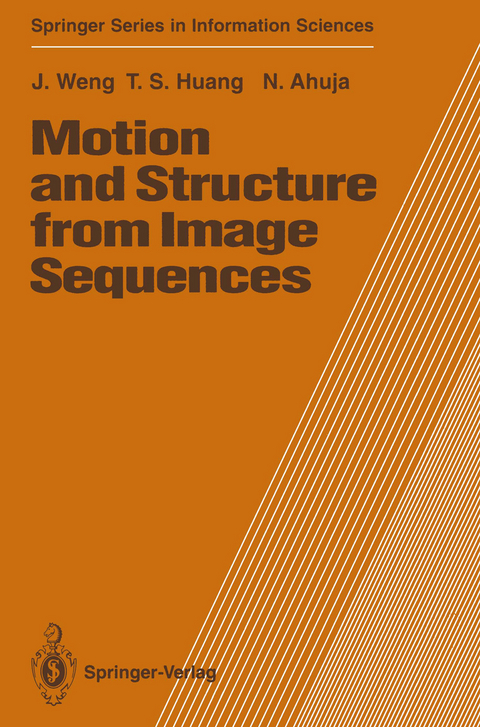
Motion and Structure from Image Sequences
Springer Berlin (Verlag)
978-3-642-77645-8 (ISBN)
Motion and Structure from Image Sequences is invaluable reading for researchers, graduate students, and practicing engineers dealing with computer vision. It presents a balanced treatment of the theoretical and practical issues, including very recent results. The rich collection of algorithms, applicable to monocular or stereo views, makes this book particularly attractive to practitioners.
1. Introduction.- 1.1 Formulation of the Problem.- 1.2 Overview of Recent Progress.- 1.3 Bibliographical Notes.- 2. Image Matching.- 2.1 Approaches to Establishing Correspondences.- 2.2 An Approach to Image Matching.- 2.3 Algorithm.- 2.4 Motion and Structure Computation.- 2.5 Refinements.- 2.6 Examples.- 2.7 Summary.- 2.8 Bibliographical Notes.- 3. Two-View Analysis.- 3.1 Some Basic Issues.- 3.2 An Algorithm.- 3.3 Error Estimation.- 3.4 Error Analysis.- 3.5 Performance.- 3.6 Summary.- 3.7 Bibliographical Notes.- Appendix 3.A Perturbation of Eigenspace.- Appendix 3.B Quaternions.- Appendix 3.C Alternative Fitting.- 4. Optimization.- 4.1 Motivations.- 4.2 Stability of Linear Algorithms.- 4.3 Maximum Likelihood Estimation.- 4.4 A Two-Step Approach and Computation.- 4.5 Minimum Variance Estimation.- 4.6 Error Estimation and Error Bounds.- 4.7 Batch and Sequential Methods.- 4.9 Summary.- 4.10 Bibliographical Notes.- Appendix 4.A Decomposability.- Appendix 4.B Weights.- Appendix 4.C Triangulation with Noise.- Appendix 4.D Matrix Derivatives.- Appendix 4.E Cramér-Rao Bound.- 5. Planar Scenes.- 5.1 Planar Scene as a Degenerate Case.- 5.2 Motion from a Plane.- 5.3 Inherent Uniqueness.- 5.4 Examples.- 5.5 Conclusions.- 5.6 Bibliographical Notes.- Appendix 5.A Conditions on the Rank of A.- Appendix 5.B Two Solutions from F.- Appendix 5.C Plane-Perceivable Surfaces.- Appendix 5.D Condition on Consistent Normals.- Appendix 5.E Two-View Algorithm.- Appendix 5.F Error Estimation.- 6. From Line Correspondences.- 6.1 Lines as Features.- 6.2 Solution and Algorithm.- 6.3 Degeneracy.- 6.4 Optimization.- 6.5 Simulations.- 6.6 Conclusions and Discussions.- 6.7 Bibliographical Notes.- Appendix 6.A Ranks.- Appendix 6.B Unique Consistent Assignment.- Appendix 6.C Degeneracy.- Appendix 6.DDistinct Locations Are Necessary.- Appendix 6.E Alternative Degeneracy Condition.- 7. Stereo.- 7.1 Stereo Camera Systems.- 7.2 Stereo Triangulation.- 7.3 Closed-Form Solution.- 7.4 Iterative Optimal Solution.- 7.5 Outliers and Robust Estimators.- 7.6 Examples.- 7.7 Without Stereo Correspondences.- 7.8 Long Image Sequences.- 7.9 Conclusions.- 7.10 Bibliographical Notes.- Appendix 7.A MWCC Theorem.- Appendix 7.B Least-Squares Matrix Fitting.- 8. Motion Modeling and Prediction.- 8.1 Coherence of Motion.- 8.2 The LCAM Model.- 8.3 Estimation and Prediction.- 8.4 Monocular Vision.- 8.5 Optimization.- 8.6 Experimental Examples.- 8.7 Summary.- 8.8 Bibliographical Notes.- Appendix 8.A Solution of Coefficient Equations.- Appendix 8.B Rotation without Precession.- Appendix 8.C Singularity of the Matrix.- References.
| Erscheint lt. Verlag | 8.12.2011 |
|---|---|
| Reihe/Serie | Springer Series in Information Sciences |
| Zusatzinfo | XV, 444 p. |
| Verlagsort | Berlin |
| Sprache | englisch |
| Maße | 155 x 235 mm |
| Gewicht | 697 g |
| Themenwelt | Informatik ► Grafik / Design ► Digitale Bildverarbeitung |
| Informatik ► Theorie / Studium ► Künstliche Intelligenz / Robotik | |
| Schlagworte | algorithms • Complexity • computer vision • Modeling • Motion Estimation • Motion Modeling and Prediction • stability • Stereo Vision • Structure from Motion |
| ISBN-10 | 3-642-77645-0 / 3642776450 |
| ISBN-13 | 978-3-642-77645-8 / 9783642776458 |
| Zustand | Neuware |
| Haben Sie eine Frage zum Produkt? |
aus dem Bereich


